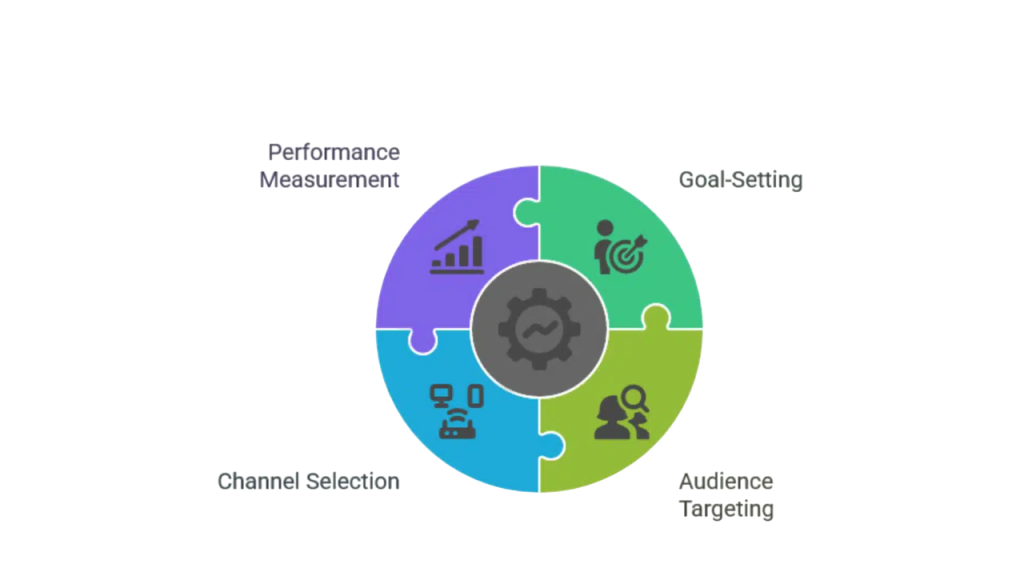
- Introduction to Digital Marketing Strategy
- Definition of Digital Marketing Strategy
- Importance of a Digital Marketing Strategy
- Difference Between Strategy and Tactics
- Core Components of a Digital Marketing Strategy
- Steps to Build a Digital Marketing Strategy
- Types of Digital Marketing Strategies
- Conclusion
Introduction to Digital Marketing Strategy
Having a strong online presence has become crucial in today’s fast-paced digital environment. However, simply being online is insufficient. Businesses require a targeted, data-driven plan and a Digital Marketing Training strategy in order to flourish. Budgets can be squandered, potential lost, and efforts might become fragmented in the absence of a defined direction.A thorough plan outlining how a company will use online channels to accomplish its marketing objectives is known as a digital marketing strategy. It entails determining the target audiences, selecting the appropriate channels, including websites, social media, email, and search engines, and creating campaigns and content that compel users to take action. Having a well-defined plan guarantees that marketing initiatives are coordinated, quantifiable, and successful in the cutthroat digital world of today. Businesses may improve their visibility, draw in the proper clients, and turn traffic into leads or sales with the aid of a clear digital marketing plan. In order to enhance outcomes, it also entails establishing key performance indicators (KPIs), evaluating data, and continuously refining campaigns. A solid digital marketing plan acts as a road map to direct all efforts and optimize return on investment (ROI), whether you’re launching a product, increasing brand awareness, Data-Driven or generating leads. In summary, digital marketing initiatives may become dispersed and ineffectual in the absence of a comprehensive plan. The cornerstone of sustained success in the digital sphere is a sound plan.
Ready to Get Certified in Digital Marketing? Explore the Program Now Digital Marketing Online Training Offered By ACTE Right Now!
Definition of Digital Marketing Strategy
A digital marketing strategy is a comprehensive plan that outlines how a business will use digital channels such as websites, search engines, social media, email, and paid ads to achieve specific marketing goals. It defines what to do, where to do it, when to do it, and how to measure success. The strategy serves as a blueprint for all online marketing efforts Become a Digital Marketing Specialist. A digital marketing strategy is a structured plan that outlines how a business will use digital channels to achieve specific marketing objectives.

It includes setting clear goals, identifying target audiences, selecting the right platforms (such as search engines, social media, email, and websites), and developing content and campaigns to engage users and drive conversions. The strategy also involves measuring performance through key metrics and optimizing efforts based on data insights. In essence, a digital marketing strategy is the blueprint for achieving success in the online marketplace.
Importance of a Digital Marketing Strategy
- Clear Direction: Provides a focused plan with defined goals and target audience.
- Better Resource Allocation: Helps allocate time, budget, and tools effectively.
- Improved ROI: Increases return on investment through targeted and measurable efforts.
- Stronger Online Presence: Builds consistent brand visibility across digital channels.
- Data-Driven Decisions: Uses analytics to refine campaigns and improve results.
- Competitive Advantage: Keeps your business ahead with strategic, TensorFlow timely actions.
- Customer Engagement: Enhances audience connection through personalized, relevant content.
- Consistency Across Channels: Aligns messaging across SEO, social media, email, and more.
- Adaptability: Helps respond quickly to market trends and digital changes.
- Long-Term Growth: Supports sustainable success with scalable marketing systems.
- Target Audience: Understanding your audience is the foundation. Create buyer personas based on demographics, interests, behavior, and pain points. Use tools like Google Analytics, social media insights, and customer surveys.
- SMART Goals: Goals must be Specific, Measurable, Achievable, Relevant, Digital Marketing Training and Time-bound. Example: “Increase website leads by 30% in 6 months” is more effective than “get more traffic.”
- Competitive Analysis: Identify your competitors, study their digital presence, and spot gaps. Tools like SEMrush, Ahrefs, and SimilarWeb help analyze their keywords, backlinks, and traffic.
- Channel Selection: Choose the right mix of digital channels based on your goals and audience. Common channels include: SEO, content marketing, email marketing, social media, PPC ads, affiliate marketing, and influencer partnerships.
- Budget Planning: Determine how much to invest in each channel. Prioritize high-ROI platforms and plan for testing and optimization.
- Content Plan: Your content strategy should align with your buyer journey from awareness to conversion. Plan blog topics, videos, email campaigns, and social content with a content calendar.
- KPIs and Metrics: Set benchmarks and track success through KPIs like traffic, conversions, cost-per-click (CPC), email open rates, social engagement, and return on investment (ROI).
- Analyze your website, social media, email list, content performance, Choose a Career in Digital Marketing and analytics to understand what’s working and what’s not.
- Align your marketing goals with business objectives. Are you looking to build awareness, generate leads, or increase customer retention?
- Use data to build detailed buyer personas. What are their goals, frustrations, buying habits, and preferred content formats?
- Evaluate your top competitors’ digital marketing strategies. Learn from their strengths and identify areas where you can differentiate.
- Decide which digital platforms you’ll use and how. For example: SEO for long-term traffic, email for nurturing leads, and PPC for fast exposure.
- Develop content aligned with each stage of the funnel: educational blog posts for awareness, product comparisons for consideration, and testimonials for decision.
- Set clear metrics for success. Use tools like Google Analytics, HubSpot, Facebook Ads Manager, or SEMrush to track and adjust.
- Launch your campaigns, monitor results, A/B test creatives and messaging, Copywriting and iterate based on data.
- Inbound Marketing Strategy: Inbound focuses on attracting customers through valuable content and organic engagement. It includes SEO, blogs, webinars, and email nurturing. The goal is to draw people in naturally rather than interrupt them.
- Outbound Marketing Strategy: Outbound involves actively reaching out to customers via ads, cold emails, and paid promotions. While often more direct, outbound can be seen as intrusive if not done thoughtfully.
- B2B Digital Marketing Strategy: B2B strategies often focus on longer sales cycles, relationship-building, and thought leadership. LinkedIn, whitepapers, email automation, SEO Keyword Research and webinars are common B2B tools.
- B2C Digital Marketing Strategy: B2C strategies emphasize fast decision-making, emotional appeal, and high-volume engagement. Instagram, Facebook, influencer marketing, and flash sales work well in B2C.
To Explore Digital Marketing in Depth, Check Out Our Comprehensive Digital Marketing Training To Gain Insights From Our Experts!
Difference Between Strategy and Tactics
| Aspect | Strategy | Tactics |
|---|---|---|
| Definition | The overall plan to achieve long-term goals | The specific actions taken to implement the strategy |
| Focus | Big-picture thinking, long-term vision | Day-to-day execution, short-term actions |
| Purpose | Guides direction and decision-making | Delivers on specific tasks and objectives |
| Example | Increase brand awareness through content marketing | Write and publish 3 blog posts per week on trending topics |
| Scope | Broad and high-level | Narrow and detail-oriented |
Core Components of a Digital Marketing Strategy

Looking to Master Digital Marketing? Discover the Digital Marketing Expert Masters Program Training Course Available at ACTE Now!
Steps to Build a Digital Marketing Strategy
Step 1: Audit Your Current Digital Presence
Step 2: Define Objectives
Step 3: Research Your Audience
Step 4: Analyze Competitors
Step 5: Choose Your Channels and Tactics
Step 6: Create a Content Plan
Step 7: Set KPIs and Measurement Tools
Step 8: Execute and Optimize
Types of Digital Marketing Strategies
Preparing for Digital Marketing Job Interviews? Have a Look at Our Blog on Digital Marketing Interview Questions and Answers To Ace Your Interview!
Conclusion
Digital marketing offers one of the most rewarding career paths today, with salaries that grow rapidly as you gain experience and sharpen your skills. From entry-level roles to executive positions, content marketing, the demand for digital marketers spans every industry and geography. By understanding salary ranges, key influencing factors, Digital Marketing Salary by Country and how to position yourself in the market, you can maximize your earning potential in this vibrant field.Digital marketing is a rapidly growing field with diverse roles that offer competitive salaries and promising career opportunities. Understanding the average salary ranges by role helps professionals and job seekers set realistic expectations and plan their career paths effectively. Factors such as experience, specialization, location, and industry significantly influence earning potential. Whether you’re just starting out as a Digital Marketing Training executive or aiming for leadership positions like a digital marketing manager or CMO, continuously upgrading your skills and staying updated with the latest trends can help maximize your income and career growth. Overall, digital marketing remains a dynamic and rewarding career choice in today’s digital-first world.




